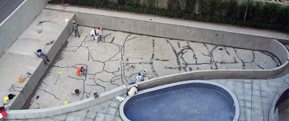There are three things that you can do about cracks: prevent, control or repair them. In our three-part series on Effective Crack Prevention, Control and Repair we look at the aforementioned three topics.
 A pool and foundation that required repair in Mexico.
A pool and foundation that required repair in Mexico.
You cannot expect to prevent all cracking; but it is possible to significantly reduce the number of cracks by taking a few important measures.
The number one way to prevent concrete cracking is to reduce the amount of water added. Less water mixed into the concrete means there will be less water to leave the concrete when it dries and as a result, less shrinkage will occur. Water should be reduced to the minimum amount required to still allow proper placement and compaction of the concrete. Using chemical water reducers will allow quite a large reduction in water and still provide workable concrete. The gradation of your aggregates has an influence as well because fine aggregates demand significantly more water than coarse aggregates. Be cautious of concrete mixes with too much sand or a high cement content that will demand more water.
More cement may mean higher strength, but it may also result in more shrinkage and additional cracks. An experienced and knowledgeable concrete supplier can deliver you a well-proportioned mix that will minimize shrinkage.
Heat generated by the hardening concrete (heat of hydration) will cause concrete to expand slightly. This can lead to cracking when the concrete cools and contracts after it has hardened. Mass concrete and hot weather will contribute to this condition Controlling heat of hydration can help to prevent these thermal shrinkage cracks by reducing the initial thermal expansion. You can also reduce heat of hydration by using low-heat-of- hydration cement or supplementary cementing materials such as fly ash and slag. Finally, if you start the concrete at a lower initial temperature by using chilled water and aggregates, you may be better able to control the cracking.
After the concrete has hardened, the less-water-is-better rule is reversed. Freshly hardened concrete must be protected from drying out too quickly. The strengthening process requires moisture and if the concrete dries out too soon the concrete will be weak and likely crack. The cement hydration process continues long after hardening, but the most critical time is in the first several days. Proper wet curing or other measures to prevent moisture evaporation are essential during this time.
Tomorrow we cover Controlling Cracking.






